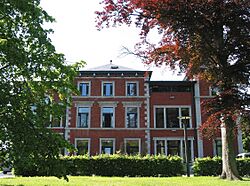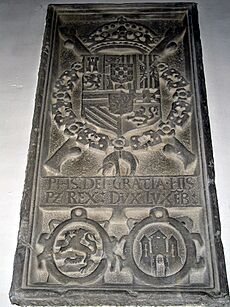Marche-en-Famenne facts for kids
Quick facts for kids
Marche-en-Famenne
Måtche-el-Fåmene (Walloon)
|
||
|---|---|---|

City hall
|
||
|
||
| Country | Belgium | |
| Community | French Community | |
| Region | Wallonia | |
| Province | Luxembourg | |
| Arrondissement | Marche-en-Famenne | |
| Area | ||
| • Total | 121.40 km2 (46.87 sq mi) | |
| Population
(2018-01-01)Lua error in Module:Wd at line 1575: attempt to index field 'wikibase' (a nil value).
|
||
| • Total | Lua error in Module:Wd at line 1,575: attempt to index field 'wikibase' (a nil value). | |
| Postal codes |
6900
|
|
| Area codes | 084 | |
Marche-en-Famenne is a lively city and municipality in Wallonia, a region in Belgium. It's located in the province of Luxembourg. The name "Marche-en-Famenne" literally means "Marche in Famenne," referring to the Famenne region where it is found.
The municipality includes several smaller towns and villages. These are Aye, Hargimont, Humain, Marche-en-Famenne itself, On, Roy, and Waha. Other nearby communities include Grimbiémont, Hollogne, Lignières, Marloie, and Verdenne.
Contents
History of Marche-en-Famenne
Early Beginnings in the Middle Ages
Long ago, in the early Middle Ages, Marche was just a tiny village. It was located near a small stream called the Marchette brook. This area was connected to the Abbey of Stavelot. In the 1100s, Marche became part of the County of La Roche.
Marche was in a great spot, right on the main road between Namur and Luxembourg City. Because of its location, it quickly grew into a town. By the 1200s, it received its official charter, which gave it special rights as a city.
Later in that century, like many medieval towns, Marche built strong defensive walls. These walls had two gates, many watchtowers, and a large keep (a type of castle tower). Inside these walls, the market place and religious groups, like the Carmes convent (founded in 1473), could grow and thrive.

Marche After the 1500s
In 1555, Philip II of Spain became ruler of many lands, including the Seventeen Provinces to the north of Marche. He reduced the freedoms of these provinces, which led to a long conflict called the Eighty Years' War.
After a peace agreement called the Pacification of Ghent, Don John of Austria (Philip II's half-brother) signed the Perpetual Edict in Marche in February 1577. This edict allowed Spanish soldiers to leave and recognized most of the cities' freedoms, except for religion. However, the war soon started again, and Don John passed away a year later.
The castle and city walls of Marche were taken down in the late 1600s by order of Louis XIV. About a hundred years later, during the French Revolution, French troops entered the city and closed the convent.
Marche also saw fighting in December 1944 during the Battle of the Bulge. This was a major battle in World War II. Today, Marche is an important regional center. It has schools, light industries, a military base, and many places for tourists to visit.
Places to See in Marche
- The city center has some interesting old buildings. These include the St Remacle church and the old Carmes convent.
- Marche is home to several museums. One is a lace museum, located in one of the last parts of the city's medieval walls. It reminds us of the many lace workers who lived in the Marche area in the 1700s.
- The Famenne museum offers a good look at the art and history of the region.
Fun Festivities
- The Grosse Biesse (which means Great Beast) carnival happens every year in February. It features a large beast, the city's mascot Gugusse, traditional giants, and other happy groups.
- A folk dance group called La Plovinette (meaning Fine Drizzle) performs traditional Walloon dances.
Notable People from Marche-en-Famenne
Many interesting people have come from Marche-en-Famenne, including:
- Pierre Bailly, a Belgian comics artist.
- Jacques Beurlet, a football player.
- André Bouchat, a politician.
- Arnaud Brihay, a Belgian artist.
- Dany, another Belgian comics artist.
- Frans Depooter, a Belgian painter.
- Willy Deweert, a Belgian writer.
- Benoît Feroumont, a Belgian comics artist.
- Charles Hanin, a politician.
- Jean Jadot, a Belgian engineer.
- Joseph Nusbaum, a Belgian architect.
- Brigitte Olivier, a Belgian judoka.
- Phil, a Belgian comics artist.
- Luc Templier, a writer.
See also
 In Spanish: Marche-en-Famenne para niños
In Spanish: Marche-en-Famenne para niños






